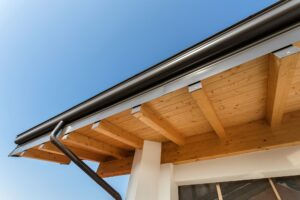Welcome to the ultimate guide on transforming your home with the art of aluminum rain gutter installation. Rain gutters play a vital role in safeguarding your home’s foundation, siding, and landscaping from water damage. This guide will walk you through the process of installing aluminum rain gutters, ensuring a seamless and effective solution for managing rainwater.
Why Aluminum Rain Gutters?
Aluminum rain gutters are a popular choice for homeowners due to their durability, affordability, and low maintenance requirements. Unlike traditional materials like steel or copper, aluminum resists rust and corrosion, making it ideal for withstanding the elements over time. Additionally, aluminum gutters are lightweight yet sturdy, making them easier to install and less prone to sagging or bending.
Enhancing Curb Appeal
Aluminum gutters come in a variety of colors and styles, allowing you to customize the look of your home while enhancing its curb appeal. Whether you prefer a classic white gutter or a seamless design that blends seamlessly with your exterior, aluminum offers versatility and aesthetic appeal.
Longevity and Durability
One of the key benefits of aluminum rain gutters is their longevity and durability. Unlike traditional materials that may deteriorate over time, aluminum is resistant to rust, corrosion, and warping, ensuring years of reliable performance without the need for frequent repairs or replacements.
Low Maintenance
Another advantage of aluminum gutters is their low maintenance requirements. Unlike wood gutters that may rot or vinyl gutters that can become brittle over time, aluminum requires minimal upkeep to keep them looking and performing their best. Simply clean them out periodically to remove debris and ensure proper water flow.
Planning Your Installation
Before diving into the installation process, it’s essential to plan carefully to ensure a successful outcome. Here are some key steps to consider:
Measuring and Sizing
Start by measuring the length of your roofline to determine how much gutter material you’ll need. Additionally, consider factors such as the pitch of your roof and the average rainfall in your area to determine the appropriate size and capacity for your gutters.
Selecting the Right Materials and Tools
Gather all the necessary materials and tools for the installation, including aluminum gutter sections, downspouts, elbows, end caps, hangers, screws, and sealant. Make sure to choose high-quality materials that are designed to withstand the elements for long-lasting performance.
Safety Precautions
Before starting any work, prioritize safety by using sturdy ladders, wearing appropriate protective gear, and taking precautions to prevent falls and injuries. If you’re not comfortable working at heights or handling power tools, consider hiring a professional gutter installer to ensure the job is done safely and correctly.
Installation Process
Now that you’ve completed the planning phase, it’s time to dive into the installation process. Follow these step-by-step instructions to install aluminum rain gutters effectively:
Step 1: Preparation
Begin by cleaning the roof and removing any debris or obstructions that could interfere with the gutter installation process. Use a broom or leaf blower to clear away leaves, branches, and other debris from the roof and gutters.
Step 2: Mounting the Gutters
Start at one end of the roofline and use a chalk line or level to mark a straight line for the gutter slope. Install the gutter hangers every 24 to 36 inches along the fascia board, ensuring they’re securely attached with screws.
Step 3: Connecting Sections
Next, connect the gutter sections using overlap joints or slip connectors, depending on the type of gutter system you’re installing. Use sealant to create watertight seals at the joints, preventing leaks and ensuring proper drainage.
Step 4: Installing Downspouts
Once the gutter sections are in place, install downspouts at strategic intervals to direct water away from your home’s foundation. Use elbows and extensions as needed to route the downspouts away from walkways and landscaping.
Step 5: Testing and Adjusting
After completing the installation, test the gutters by running water through them and checking for any leaks or overflow issues. Make any necessary adjustments to ensure proper water flow and drainage away from your home.
Maintenance Tips
To keep your aluminum rain gutters in top condition, follow these maintenance tips:
- Clean gutters regularly to remove debris and prevent clogs.
- Check for signs of damage or corrosion and repair any issues promptly.
- Trim overhanging branches to prevent debris buildup and damage to the gutters.
- Inspect the gutter system after heavy storms or high winds and make any necessary repairs.
Transform Your Home: The Art of Aluminum Rain Gutter Installation
Transforming your home with aluminum rain gutters is a practical and effective way to protect your investment and enhance its beauty. By following the steps outlined in this guide, you can install durable and reliable gutters that will safeguard your home for years to come.
FAQs
How long do aluminum rain gutters last?
Aluminum rain gutters can last up to 20 years or more with proper maintenance and care.
Can I install aluminum gutters myself, or should I hire a professional?
While DIY installation is possible for experienced homeowners, hiring a professional gutter installer can ensure the job is done safely and correctly, minimizing the risk of leaks or damage.
Are aluminum gutters resistant to rust and corrosion?
Yes, aluminum gutters are highly resistant to rust and corrosion, making them ideal for long-term use in all types of climates.
What colors are available for aluminum gutters?
Aluminum gutters come in a wide range of colors to match your home’s exterior, including white, brown, black, and more.
How often should I clean my aluminum gutters?
It’s recommended to clean aluminum gutters at least twice a year to remove debris and prevent clogs that can lead to water damage.
Can aluminum gutters be painted?
Yes, aluminum gutters can be painted to match your home’s color scheme or refresh their appearance over time.
Conclusion
In conclusion, aluminum rain gutter installation is a valuable investment in your home’s protection and aesthetics. By following the steps outlined in this guide and staying proactive with maintenance, you can enjoy the benefits of durable, reliable gutters that enhance your home’s curb appeal and longevity.








